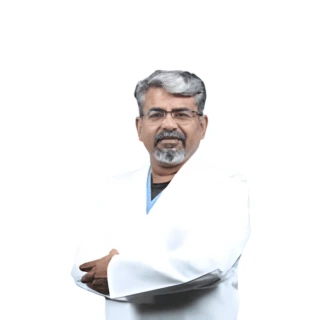Transjugular Liver Biopsy is a minimally invasive diagnostic procedure used to assess liver tissue without traditional surgical methods. During this intervention, a catheter is guided through the jugular vein, avoiding the need for an abdominal incision. Once in the hepatic veins, a small tissue sample is obtained, providing valuable information about liver health and pathology. This technique is particularly beneficial for patients with coagulation disorders or ascites. While it carries some risks, its less invasive nature makes it a preferred option for individuals requiring liver tissue sampling, allowing for the diagnosis and management of various liver diseases.
Why Do You Need Transjugular Liver Biopsy?
Transjugular Liver Biopsy is a valuable diagnostic tool to assess liver health and identify underlying liver conditions. Several factors contribute to the need for this procedure:
- Coagulation Disorders: Patients with coagulation disorders, where normal blood clotting is impaired, may not be suitable candidates for traditional percutaneous liver biopsies due to an increased risk of bleeding. Transjugular Liver Biopsy provides a safer alternative for these individuals.
- Ascites: Individuals with ascites, the accumulation of fluid in the abdominal cavity, face challenges with percutaneous biopsies. Transjugular Liver Biopsy is preferred in such cases as it avoids the risk of complications associated with abdominal fluid.
- Obesity: In obese patients, the thickness of abdominal wall tissues can make percutaneous liver biopsy technically challenging. Transjugular access allows for a more controlled and accurate sampling of liver tissue in these cases.
- Suspected Liver Disease: When liver disease is suspected, but a clear diagnosis is not evident through imaging or blood tests, a liver biopsy is often necessary. Transjugular Liver Biopsy provides a safe and effective means of obtaining tissue samples for a definitive diagnosis.
- Risk Mitigation: The procedure is particularly beneficial for patients at higher risk of bleeding complications, such as those with advanced liver disease or portal hypertension. Transjugular access minimizes the risk of bleeding associated with percutaneous liver biopsies.
- Chronic Liver Conditions: Patients with chronic liver conditions, such as cirrhosis, may require periodic monitoring of liver health. Transjugular Liver Biopsy allows for repeated sampling without the potential risks associated with multiple percutaneous biopsies.
Types of Transjugular Liver Biopsy
Transjugular Liver Biopsy encompasses different approaches, each tailored to specific clinical scenarios and patient needs. Here are common types of Transjugular Liver Biopsy:
- Standard Transjugular Liver Biopsy: In this approach, a catheter is guided through the jugular vein to access the hepatic veins. A biopsy needle is then advanced through the catheter to obtain liver tissue samples. This is the standard technique for assessing liver pathology.
- Wedged Hepatic Venous Pressure Measurement: This type of biopsy involves obtaining liver tissue samples and measuring the pressure within the hepatic veins. It provides valuable information about portal hypertension, aiding in assessing and managing conditions such as cirrhosis.
- Pressure Gradient Measurement: This advanced type measures the pressure gradient between the hepatic veins and the inferior vena cava. Elevated pressure gradients can indicate significant portal hypertension, helping guide therapeutic interventions.
- Portal Venous Pressure Measurement: Some cases may involve measuring the pressure directly within the portal vein. This provides detailed information about portal hypertension and aids in treatment planning.
- Combined Procedures: Transjugular Liver Biopsy can be combined with other interventions, such as angiography or portography, to comprehensively assess liver anatomy and pathology.
How Patients are Selected for the Procedure?
Selecting patients for Transjugular Liver Biopsy involves carefully considering various factors to ensure the procedure's safety and effectiveness. Patient selection is typically based on the following criteria:
- Coagulation Disorders: Patients with coagulation disorders or those taking anticoagulant medications may be considered for Transjugular Liver Biopsy, as it poses a lower risk of bleeding complications compared to percutaneous biopsies.
- Ascites: Individuals with ascites, the accumulation of fluid in the abdominal cavity, may undergo a Transjugular Liver Biopsy to avoid the potential complications associated with percutaneous biopsies in the presence of abdominal fluid.
- Obesity: In obese patients, the thickness of abdominal wall tissues can make percutaneous liver biopsy challenging. Transjugular access allows for a more controlled and accurate liver tissue sampling in these cases.
- Suspected Liver Disease: When imaging or blood tests are inconclusive, patients with suspected liver disease requiring a definitive diagnosis may be selected for Transjugular Liver Biopsy.
- Risk of Bleeding: Individuals at a higher risk of bleeding complications, such as those with advanced liver disease or portal hypertension, may benefit from Transjugular Liver Biopsy as it minimizes the risk associated with percutaneous approaches.
- Chronic Liver Conditions: Patients with chronic liver conditions, including cirrhosis, may require periodic monitoring of liver health. Transjugular Liver Biopsy allows for repeated sampling without the potential risks associated with multiple percutaneous biopsies.
- Multidisciplinary Assessment: Patient selection involves a collaborative effort between hepatologists, interventional radiologists, and other specialists. A thorough evaluation of the patient's overall health, liver condition, and suitability for the procedure is conducted.
Diagnostic Tests and Evaluations Performed to Determine the Need for Transjugular Liver Biopsy
Several diagnostic tests and evaluations are performed to determine the need for Transjugular Liver Biopsy, ensuring its appropriateness and effectiveness in assessing liver conditions. These may include:
- Liver Function Tests: Blood tests measuring liver enzymes, bilirubin, and other markers provide initial insights into liver health and potential abnormalities.
- Imaging Studies: Imaging modalities such as ultrasound, CT scans, or MRI are utilized to visualize the liver's structure and identify abnormalities, such as nodules or cirrhotic changes.
- Endoscopic Procedures: Endoscopic evaluations, such as Endoscopic Retrograde Cholangiopancreatography (ERCP), may be conducted to assess the biliary system and identify any blockages or abnormalities.
- Coagulation Profile: An assessment of the patient's coagulation profile is crucial, especially if there is a history of bleeding disorders or anticoagulant medication use. This helps determine the risk of bleeding complications during the biopsy.
- Platelet Count: A low platelet count may indicate portal hypertension, which can influence the decision to perform a Transjugular Liver Biopsy.
- Clinical Evaluation: A comprehensive clinical evaluation, including the patient's medical history and symptoms, aids in determining the underlying liver condition and the necessity of a liver biopsy.
- Hepatic Venous Pressure Gradient (HVPG) Measurement: In cases where portal hypertension is suspected, measuring the HVPG provides valuable information and aids in decision-making regarding the need for a biopsy.
- Multidisciplinary Consultation: A collaborative approach involving hepatologists, interventional radiologists, and other specialists ensures a comprehensive assessment. This multidisciplinary consultation helps determine the most appropriate diagnostic approach for each case.
Know Your Treatment Cost
Get a cost estimate based on your condition and hospital preferences.
Risks and Benefits Associated with the Chosen Transjugular Liver Biopsy
Benefits of Transjugular Liver Biopsy:
- Safer for Coagulation Disorders: Transjugular Liver Biopsy is advantageous for patients with coagulation disorders or those taking anticoagulant medications. Compared to percutaneous biopsies, the transjugular approach minimizes the risk of bleeding complications.
- Suitable for Ascites: Patients with ascites, a common complication in liver disease, may undergo Transjugular Liver Biopsy more safely than percutaneous biopsies, as it avoids the potential complications associated with abdominal fluid.
- Reduced Risk in Obesity: In obese patients, the thickness of abdominal wall tissues can make percutaneous liver biopsy challenging. Transjugular access allows for a more controlled and accurate liver tissue sampling in these cases.
- Comprehensive Assessment: Transjugular Liver Biopsy provides tissue samples for pathology and enables additional hemodynamic assessments, such as wedged hepatic venous pressure or portal venous pressure measurement. This aids in a more comprehensive evaluation of liver health.
Risks of Transjugular Liver Biopsy:
- Vascular Complications: While considered safer, there is still a risk of vascular complications associated with catheter insertion, such as hematoma or vessel perforation.
- Infection: Any invasive procedure carries a risk of infection. Proper sterile techniques are employed, but there is always a small risk.
- Bleeding: Although less common than in percutaneous biopsies, there is still a risk of bleeding, especially in patients with significant liver disease.
- Potential for Hepatic Artery Injury: In rare cases, there is a risk of injury to the hepatic artery during the procedure.
- Post-Embolization Syndrome: If portal venous pressure measurement is performed and embolization is needed, patients may experience post-embolization syndrome with flu-like symptoms.
The decision to undergo a Transjugular Liver Biopsy involves carefully considering the patient's health, the suspected liver condition, and the potential risks and benefits associated with the procedure. This is typically made through collaborative decision-making between the patient and the healthcare team.
What to Expect After a Transjugular Liver Biopsy?
After undergoing a Transjugular Liver Biopsy, patients can anticipate a post-procedural recovery period with specific expectations for care and follow-up. Here's what to expect:
- Immediate Post-Procedure Monitoring: Patients are closely monitored in a recovery area following the biopsy. Vital signs are observed, and immediate post-procedural discomfort or complications are promptly addressed.
- Pain Management: Patients may experience discomfort at the catheter insertion site or neck area. Pain management strategies, including analgesic medications, may be provided to alleviate any post-procedural pain or discomfort.
- Catheter Care Instructions: If an external drainage catheter is in place, patients receive detailed instructions on how to care for it. This includes maintaining cleanliness, monitoring for signs of infection, and ensuring the secure positioning of the catheter.
- Activity Restrictions: Patients may be advised to avoid strenuous physical activities for a certain period to minimize the risk of complications. Specific activity restrictions will depend on individual patient characteristics and the presence of any external catheter.
- Transition to Internal Drainage: In cases where an external drainage catheter is used, the transition to internal drainage occurs once the procedure achieves its intended goals. This may involve removing the external catheter.
- Post-Procedural Imaging: Follow-up imaging studies, such as ultrasound or CT scans, may be scheduled to assess the liver's condition and ensure no immediate complications.
- Follow-up appointments: Scheduled follow-up appointments with the healthcare team are crucial. These appointments allow for assessing the biopsy results, monitoring for any ongoing issues, and addressing patient concerns.
- Resumption of Normal Activities: Patients can gradually resume normal activities based on healthcare provider recommendations. The timeline for resuming activities will depend on individual recovery progress and any specific post-procedural instructions.
- Patient Education: Patients and their caregivers will receive education on signs of complications, proper catheter care (if applicable), and when to seek medical attention.
How is Transjugular Liver Biopsy Performed?
Transjugular Liver Biopsy is a specialized procedure performed by interventional radiologists to obtain liver tissue for diagnostic purposes. Here are the key steps involved in the performance of Transjugular Liver Biopsy:
- Patient Preparation: The patient undergoes pre-procedural assessment, including a medical history review and relevant imaging studies. Informed consent is obtained, and the patient is positioned on the procedure table.
- Local Anesthesia: The procedure is typically performed under local anesthesia. A local anesthetic is administered to numb the skin overlying the jugular vein, the point of entry.
- Jugular Vein Access: A small incision is made over the jugular vein, usually on the right side of the neck. A catheter is then inserted through the jugular vein and guided under fluoroscopic or ultrasound imaging to reach the hepatic veins within the liver.
- Wedged Hepatic Venous Pressure Measurement (Optional): A pressure measurement may sometimes be taken within the hepatic veins to assess portal hypertension. This step is optional and depends on the clinical objectives.
- Biopsy Needle Insertion: A biopsy needle is advanced through the catheter and into the hepatic veins. The needle is then used to obtain small tissue samples from the liver.
- Tissue Collection: The obtained liver tissue samples are collected and sent to the pathology laboratory for analysis. Multiple samples may be taken to ensure an accurate representation of liver pathology.
- Closure and Dressing: After the biopsy, the catheter is removed, and the entry site is closed with sutures or sterile dressings. Pressure is applied to minimize bleeding.
- Post-Procedural Monitoring: The patient is closely monitored in a recovery area for immediate post-procedural complications. Vital signs are observed, and pain management is provided as needed.
 10 December,2025
Read More
10 December,2025
Read More




 10 December,2025
Read More
10 December,2025
Read More
 09 December,2025
Read More
09 December,2025
Read More
 05 December,2025
Read More
05 December,2025
Read More
 04 December,2025
Read More
04 December,2025
Read More
 27 November,2025
Read More
27 November,2025
Read More
 25 November,2025
Read More
25 November,2025
Read More